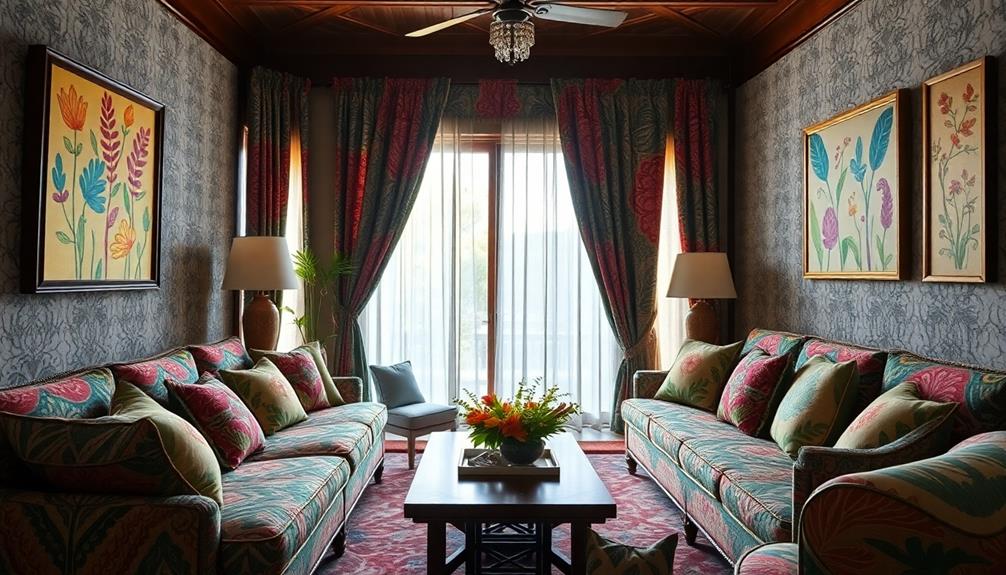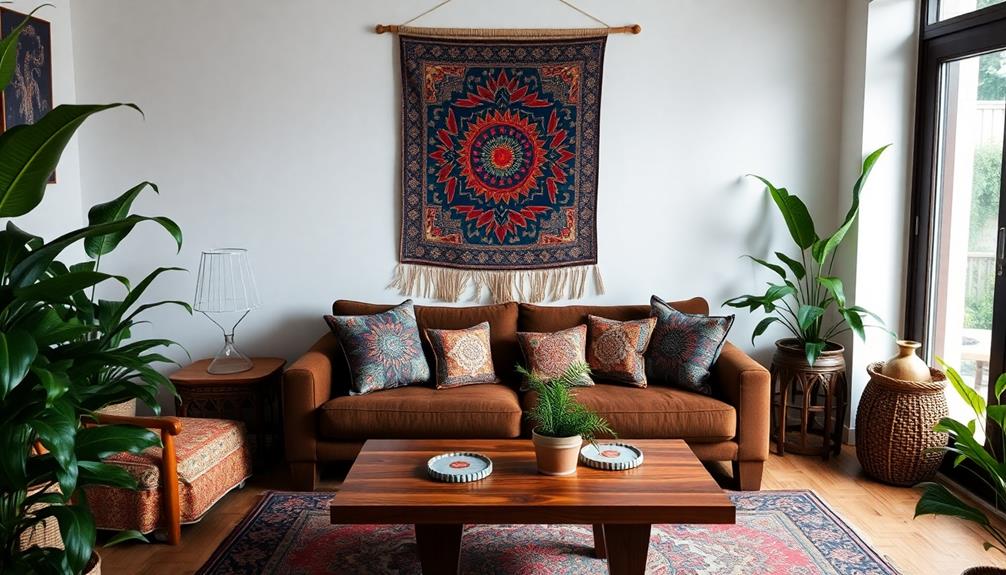Batik's vibrant patterns and rich cultural significance can transform your home decor into a celebration of artistry. You can add a cultural touch with intricately designed pillow covers, curtains, or table runners. These unique textiles not only brighten your space but also tell a story of Indonesian heritage. Batik is versatile, fitting seamlessly into both traditional and modern styles. By incorporating it into wall hangings or DIY projects, you'll create personalized focal points. Embracing batik not only enhances your decor but also connects you to a rich cultural legacy. Uncover more ideas to stylishly integrate this design trend into your home.
Key Takeaways
- Batik textiles, like pillow covers and curtains, add vibrant cultural patterns to enhance any home decor.
- Incorporating batik tablecloths and runners creates a unique dining experience infused with artistic heritage.
- Wall hangings and framed batik art serve as striking focal points that celebrate Indonesian craftsmanship.
- DIY batik projects allow homeowners to personalize spaces while honoring traditional designs and techniques.
- Everyday accessories, such as bags and decor items, infuse functional spaces with a rich cultural touch.
Understanding Batik

Batik, with its intricate patterns and vibrant colors, is more than just a fabric—it's a window into Indonesian culture. This traditional art form employs a wax-resist dyeing technique, allowing local artisans to create unique designs that tell stories of their heritage. Each piece of batik reflects the cultural significance of its region, showcasing diverse motifs that resonate with local traditions and natural beauty.
Additionally, the use of traditional artistry in masks complements the batik's vibrant aesthetic, further enriching the cultural tapestry of Indonesian decor.
When you explore batik, you'll discover that the craftsmanship involves meticulous steps. Artisans draw designs with molten wax before dyeing the fabric, making each creation labor-intensive and one-of-a-kind.
Javanese batik often exudes courtly elegance, while Balinese patterns burst with vibrancy, capturing the essence of Indonesian life.
Beyond traditional clothing, batik's versatility extends to home decor and accessories, making it a valuable addition to contemporary design. Incorporating batik into your living space not only enriches your surroundings but also celebrates Indonesian cultural heritage.
The Resurgence of Batik

A renewed interest in batik is sweeping through modern fashion, particularly among younger generations enthusiastic to embrace their cultural roots. This resurgence of batik is more than just a trend; it's a celebration of cultural heritage.
You'll find intricate designs and diverse cultural patterns and motifs making their way into everyday wear, giving a fresh twist to traditional costumes. Additionally, batik's unique artistic expressions reflect the rich Indonesian cultural heritage, similar to the artistry seen in Indonesian decor masks.
Communities like Remaja Nusantara are playing an essential role by hosting events that teach the art of wearing batik, bridging the gap between tradition and contemporary fashion. Fashion designers are increasingly integrating batik motifs into their collections, perfect for formal occasions like engagements and weddings.
Imagine:
- Elegant batik sarongs flowing gracefully at a summer gathering
- A chic batik blouse paired with your favorite jeans for a casual outing
- Intricate patterns adorning both men's and women's attire, showcasing craftsmanship
- High-profile figures, like Beyoncé and the Duchess of Cambridge, donning batik designs, elevating its status globally
As you explore modern fashion, you'll discover that wearing batik not only makes a bold statement but also honors the rich history that it represents.
Modern Applications of Batik

Increasingly, homeowners are embracing batik in their interior design choices, transforming spaces with its vibrant patterns and rich cultural significance. You can find batik making its way into various home decor items, such as bed linens, pillow covers, and curtains. These pieces add a stylish cultural touch that enhances your living environment.
Furthermore, incorporating elements like Indonesian decor masks can further enrich the aesthetic experience. Designers are innovating by creating batik-inspired accessories like table runners, wall art, and decorative cushions, blending traditional motifs with modern aesthetics.
The intricate designs of batik are versatile, allowing you to incorporate them into a range of applications beyond clothing. This promotes the adoption of batik in home furnishings and art pieces that celebrate cultural heritage.
Additionally, eco-conscious consumers can enjoy batik as sustainable techniques are being employed in the production of these home goods, utilizing eco-friendly materials.
Thanks to the rise of digital platforms, you can easily discover and purchase batik home decor products globally, enhancing their visibility and appreciation in diverse markets. By integrating batik into your home decor, you not only beautify your space but also honor its rich cultural legacy.
Batik's Global Impact

With roots deep in Indonesian culture, batik's influence has surged across the globe, enchanting diverse audiences. This intricate art form, celebrated for its unique batik patterns, has found a cherished place in high fashion and everyday life.
The vibrant colors and intricate patterns of batik not only elevate personal style but also serve as a reflection of cultural heritage, making it a favored choice in both Indonesian decorative pillows and fashion. You can see its global appeal reflected in various ways:
- Celebrities like Bill Gates, Barack Obama, and Beyoncé don batik designs, showcasing its versatility.
- The Duchess of Cambridge has graced public events in a stunning batik dress by Diane von Furstenberg, marrying tradition with modern elegance.
- International designers such as Nicole Miller and Dries Van Noten embrace batik motifs, breathing fresh life into their collections.
- Major fashion weeks now highlight batik's beauty, amplifying its cultural influences and artistic merit.
Incorporating Batik in Your Home

Batik transforms any home into a vibrant cultural haven, offering countless ways to incorporate its rich patterns. You can easily enhance your home decor with batik by adding colorful pillow covers, bed linens, and curtains that reflect its intricate patterns.
Consider using batik tablecloths and runners to elevate your dining experiences, showcasing traditional craftsmanship while sharing stories behind each design. Batik wall hangings or framed art pieces can serve as striking focal points, celebrating the cultural aesthetic of this Indonesian heritage.
Here's a quick reference for incorporating batik into your home:
| Element | Application | Benefits |
|---|---|---|
| Textiles | Pillow covers, bed linens, curtains | Adds vibrant color and comfort |
| Dining | Tablecloths, runners | Enhances meals with cultural flair |
| DIY Projects | Art pieces, upcycled furniture | Personalizes space while honoring tradition |
Incorporating batik into everyday accessories, like bags or wall organizers, also brings a touch of Indonesian heritage to your functional items. Embrace these ideas, and let the beauty of batik enrich your living space!
Frequently Asked Questions
What Is the Cultural Significance of Batik?
Batik's cultural significance lies in its rich storytelling, showcasing regional traditions and social status. You'll appreciate how each intricate design reflects Indonesia's heritage, connecting you to a vibrant history and a shared sense of identity.
What Is the Batik Design?
Batik design features intricate patterns created through a wax-resist dyeing technique. You'll notice detailed motifs that reflect cultural stories and local nature, each symbolizing unique meanings tied to specific regions in Indonesia.
What Are the 5 Major Types of Batik Design?
You'll discover five major batik designs: Parang's diagonal strength, Kawung's circular purity, Mega Mendung's cloud connection, Truntum's starry hope, and Buketan's floral beauty. Each design carries unique cultural meanings and historical significance.
What Is Batik in Simple Terms?
Batik's a traditional fabric art where artists use wax to create intricate patterns. It's unique to regions, showcasing culture and nature. Each piece tells a story, reflecting the craftsmanship and heritage of its origin.
Conclusion
As you embrace the beauty of batik in your home, imagine the stories each piece could tell. Will your living space transform into a vibrant tapestry of culture, sparking conversations and inspiring creativity? Picture the delicate patterns weaving through your decor, adding depth and warmth. But wait—what if the perfect batik piece is still out there, waiting for you to discover it? Immerse yourself in this trend and let your home reflect the rich heritage of batik, one stunning design at a time.









